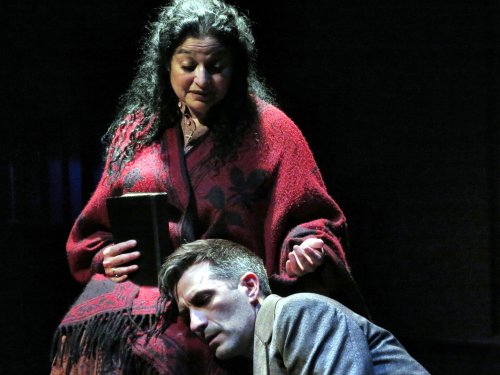Crime and Punishment
The play is a stripped-down version of the Dostoyevsky's novel “Crime and Punishment” focusing on the book’s core themes of criminality, morality, and guilt.

Josh Tyson as Raskolnikov in a scene from Phoenix Theatre Ensemble’s production of “Crime and Punishment” at the Gural Theatre, A.R.T./New York Theatres (Photo credit: Jonathan Slaff)
[avatar user=”Scotty Bennett” size=”96″ align=”left”] Scotty Bennett, Critic[/avatar]
There was a radio show in the 1930’s and 1940’s whose opening line was “What evil lurks in the hearts of men?” It was based on a series of crime novels about a secretive vigilante detective who solved all types of crimes. The underlying idea was that the vigilante was able to understand the psychological motivations of people that led them to commit crimes. It was not a new theme in crime stories with variations going back to the mid-nineteenth century, the most notable being a serial novel created by Fyodor Dostoyevsky in 1866.
Crime and Punishment by Marilyn Campbell and Curt Columbus is based on Dostoyevsky’s classic novel of the same name. The play is a stripped-down version of the novel focusing on the book’s core themes of criminality, morality, and guilt. The novel is a complex study of the consequences of the crime of murder, influenced by a corrupt ideology of superiority in conflict with a sense of morality. The result is mental instability in the central character brought on by guilt and a confused sense of responsibility.
The play’s cast of three actors are expertly directed by Karen Case Cook. It is a play worth seeing for the outstanding performances, even if you are not familiar with Dostoyevsky novel. If you do know the book, you may be disappointed by the simplification of the major themes. The play demands careful attention to the dialogue to fully grasp the thematic structure of the story.

Josh Tyson as Raskolnikov plays the character for the entire show and gives a solid performance. The other two actors are John Lenartz as Inspector Porfiry Petrovich and other male characters, and Elise Stone as Sonia and other female characters. This group of actors solidly inhabit the key characters and each of the other characters they play.
The play starts with Porfiry chatting with Raskolnikov in a battle of wits about the murders of Alyona Ivanova, a pawnbroker, and her sister Lizaveta. Raskolnikov is an impoverished law student who is in desperate financial circumstances. He has been surviving on the generosity of his mother and sister, and by pawning items to Alyona Ivanova. His warped ideology and financial woes lead him to the murder of Ivanova and her sister.
Inspector Porfiry is convinced that Raskolnikov is the murderer but he does not have solid proof. He needs Raskolnikov to confess. The inspector’s understanding of criminal psychology shows him how fragile is his suspect’s mental state. The back and forth between the two protagonists plays out over the play to a final resolution with the Inspector achieving his goal and Raskolnikov finding resolution to his mental struggles.

John Lenartz as Inspector Porfiry in a scene from Phoenix Theatre Ensemble’s production of “Crime and Punishment” at the Gural Theatre, A.R.T./New York Theatres (Photo credit: Jonathan Slaff)
Tyson’s portrayal of Raskolnikov is riveting as he moves through the elements leading inexorably to his mental collapse. The exchanges with Porfiry are woven together with encounters with the people in his life that had an impact on his present mental state. Each of these ancillary scenes are used to fill gaps in the storyline needed to clarify Raskolnikov’s mental state and the exchanges that take place with the inspector.
A crucial scene takes place when the inspector recalls an article written by Raskolnikov. The point of the article was that there is a difference between certain types of people that he calls “ordinary” and “extraordinary.” He argues that “extraordinary” people can overstep the normal bounds of morality if they decide it is necessary for the “good” of the society. This exchange shows the rationale behind the murders and exposes one of the core conflicts afflicting Raskolnikov.
Lenartz gives a first-rate performance not only of Porfiry, but of all the characters he inhabits. He transforms into each of these characters with small changes in costume and with his movement and speech. He makes each of the ancillary characters distinct. This same skill is evident in Stone’s portrayal of all the women in the story, with small changes in costume and physicality she becomes a new character. The only quibble I have is with her portrayal of the character Sonia. The age of the character is important in the story, and although Stone does not fit the part, it does not diminish the impact of the performance.

Josh Tyson and John Lenartz in a scene from Phoenix Theatre Ensemble’s production of “Crime and Punishment” at the Gural Theatre, A.R.T./New York Theatres (Photo credit: Jonathan Slaff)
The set consists of three small benches placed in an otherwise empty performance space. It is a way of forcing the audience to focus on the dialogue and actions. The lighting design by Tony Mulanix is critical in this type of arrangement in supporting the focus of the action. Debbi Hobson’s costume design is effective in setting the period of the story to the mid to late 19th century. The props design by Buffy Cardoza and sound design by Ellen Mandel effectively complement the other elements of the production design.
Crime and Punishment (through January 28, 2024)
Phoenix Theatre Ensemble
Gural Theatre, A.R.T./New York Theatres, 502 West 53rd Street, in Manhattan
For tickets, visit https://www.phoenixtheatreensemble.org /calendar.
Running time: 95 minutes without an intermission






Leave a comment